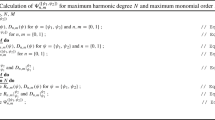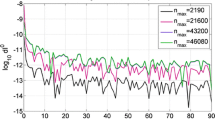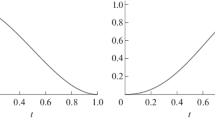Abstract
In this paper, two applications of numerical integration in geodesy and geophysics are presented. In the first application, the Molodenskij truncation coefficients for the Abel-Poisson kernel are computed using eleven different numerical integration procedures, namely two-, three-, four-, and five-point Gaussian, Gauss–Kronrod, trapezoidal rule, Simpson and its adaptive mode, Romberg, Lobatto, and Sard’s approximating functional numerical integration methods. The coefficients are computed for truncation degree 90, and truncation radius \(6^\circ\). The results are then compared with an independent method for calculating these coefficients. It is shown that numerical integration methods represent better accuracy. In the second application, the gravity accelerations at sea surface in Qeshm in southern Iran are calculated using the spherical spline numerical integration method. The formulae for spherical spline numerical integration in two different modes weighted and without weight are derived. The special case when the weight of the integral is the so-called Stokes’ kernel is thoroughly investigated. Then, the results are used to generate gravity accelerations. First, the geoid height from the sum of the mean sea level and sea surface topography is calculated. Then, a spherical spline analytical representation—with unknown coefficients—is considered for the gravity anomaly. In the next step, using the Stokes’ formula for the integral relation between geoid height and gravity anomaly, the unknown coefficients in the previous step are calculated and subsequently the gravity anomalies are derived. Adding the gravity of the reference ellipsoid to the gravity anomalies, the actual gravity accelerations at sea surface in Qeshm are calculated. To analyze the accuracy, the derived values are compared with the values observed by shipborne gravimetry. It is shown that using Bernstein polynomials as basis function for calculating numerical integration has a better accuracy than other numerical integration methods of the same degree.


















Similar content being viewed by others
Availability of data and material
The observation data for this study are available for public use.
Code availability
MATLAB and C++ codes for the applications presented in this paper are available.
References
Abramowitz M, Stegun IA (1972) Handbook of mathematical functions with formulas, graphs, and mathematical tables. Dover, New York
Akhtar N, Michel V (2012) Reproducing-kernel-based splines for the regularization of the inverse ellipsoidal gravimetric problem. Applicable Anal 91:2105–2132
Chuaning Z, Zhonglian L, Xiaoping W (1998) Truncation formulae for disturbing gravity vector. J Geodesy 72:119–123
Davis PJ (1975) Interpolation and approximation. Courier Corporation, New York
Ellmann M, Vanicek P (2007) UNB application of Stokes–Helmert’s approach to geoid computation. J Geodyn 43:200–213
Freeden W (1981) On spherical spline interpolation and approximation. Math Methods Appl Sci 3:551–575
Freeden W, Gervens T, Schreiner M (1998) Constructive approximation on the sphere. Oxford University Press, England
Freeden W, Gutting M (2018) Integration and cubature methods: a geomathematically oriented course. Chapman and Hall, Taylor Francis Group, Boca Raton
Heiskanen W, Moritz H (1967) Physical geodesy. Freeman corporation, San Fransisco
Kiani M (2020a) Local geoid height interpolation and approximation using moving least squares approach. J Geodesy Geodyn 11(2):120–126
Kiani Shahvandi M (2020b) Numerical solution of ordinary differential equations in geodetic science using adaptive Gauss numerical integration method. Acta Geodaetica et Geophysica 55:277–300
Kiani M (2020c) Simultaneous approximation of a function and its derivatives by Sobolev polynomials: Applications in satellite geodesy and precise orbit determination for LEO CubeSats. J Geodesy Geodyn 11(5):376–390
Kiani M (2020d) Spherical approximating and interpolating moving least squares in geodesy and geophysics: a case study for deriving gravity acceleration at sea surface in the Persian Gulf. J Geodetic Sci. https://doi.org/10.1515/jogs-2020-0112
Kiani M (2020e) Template-based smoothing functions for data smoothing in Geodesy. J Geodesy Geodyn 11(4):300–306
Kiani M, Chegini N, Safari A, Nazari B (2020f) Spheroidal spline interpolation and its application in geodesy. Geodesy Cartogr 46(3):123–135. https://doi.org/10.3846/gac.2020.11316
Kiani Shahvandi M, Chegini N (2019) Ellipsoidal spline functions for gravity data interpolation and smoothing. J Earth Obs Geomat Eng 3(2):1–11
Kiani Shahvandi M, Chegini N, Safari A, Nazari B (2020) Producing gravity acceleration at sea surface in Persian Gulf using ellipsoidal splines. jgit 8(1):63–78
Kiani M (2020g) Comparison between compactly-supported spherical radial basis functions and interpolating moving least squares meshless interpolants for gravity data interpolation in geodesy and geophysics. arXiv:2005.08207
Kincaid D, Cheney W (1990) Numerical analysis: mathematics of scientific computing. Cole publishing corporation, Pacific Grove
Kreyszig E (1979) Bernstein polynomials and numerical integration. Numer Methods Eng 14:292–295
Laurie DP (1990) Calculation of the Gauss-Kronrod quadrature rules. Mathe Comput 66:1133–1145
Paul MK (1973) A method of evaluating the truncation error coefficients of geoidal height. Bull Geod 110:413–425
Paul MK (1983) Recurrence relations for the truncation error coefficients for the extended Stokes function. Bull Geod 57:152–166
Safari A, Sharifi MA, Amin H, Foroughi I (2014) Gravity acceleration at the sea surface derived from satellite altimetry data using harmonic splines. J Earth Space Phys 40:35–46
Sjoberg LE, Shirazian M (2012) Solving the direct and inverse geodetic problems on the ellipsoid by numerical integration. J Surv Eng 138:9–17
Vanicek P, Kleusberg A, Chang RG, Fashir H, Christou N, Hofmann M, Kling T, Arsenault T (1987) The Canadian geoid. UNB technical report, No, p 129
Wahba G (1981) Spline interpolation and smoothing on the sphere. Soc Ind Appl Math 2:5–16
Funding
This work did not receive funding from any organization.
Author information
Authors and Affiliations
Corresponding author
Ethics declarations
Conflict of interest
Authors declare that there is no conflict of interest among them.
Additional information
Communicated by Michal Malinowski (CO-EDITOR-IN-Chief)/Ramon Zuñiga, Ph.D. (CO-EDITOR-IN-CHIEF).
Rights and permissions
About this article
Cite this article
Kiani Shahvandi, M. Applications of numerical integration in geodesy and geophysics. Acta Geophys. 69, 29–45 (2021). https://doi.org/10.1007/s11600-020-00525-x
Received:
Accepted:
Published:
Issue Date:
DOI: https://doi.org/10.1007/s11600-020-00525-x




